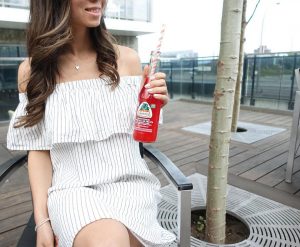
Eight years ago, our Sean Beckingham jumped headfirst into the world of digital marketing and Branding & Buzzing was born. Since then, a lot has changed for us, and even more has changed in the digital marketing landscape, especially when it comes to the role of influencers.
 These days, influencers are one of our most important resources when it comes to connecting and engaging with an audience. In fact, the consumer population is gradually turning away from traditional advertising, allowing influencer marketing to lead the way as the fastest-growing online customer acquisition method.
These days, influencers are one of our most important resources when it comes to connecting and engaging with an audience. In fact, the consumer population is gradually turning away from traditional advertising, allowing influencer marketing to lead the way as the fastest-growing online customer acquisition method.
Influencer marketing is one of our core services, as we collaborate one-on-one and have long-term relationships with many of Canada’s favourites.
“Influencers offer a lot of opportunity for content and connections with brands,” says Beckingham. “True content creators are great to follow.”
At its heart, influencer marketing is seen to be more authentic and authoritative as influencers not only advertise products to their audience but also offer inspiration on how to use them. Perhaps this is why 40% of customers have actually purchased a product after seeing an influencer use it on social media and 70% of teens trust YouTube influencers more than traditional celebrities.
“Back when we started the business, the platform that dominated the social space was Twitter. That’s where we would find bloggers to work with, that’s what they used to be called,” explains Branding & Buzzing partner Marian Staresinic, who joined forces with Sean in 2012.
Things are a little different today; now they’re called influencers and dominate across all platforms.
Whether it’s an action-packed vlog, a quirky blog post or a colourful Instagram image, almost half of consumers “depend on influencer recommendations” to determine which products to purchase, according to the Digital Marketing Institute. Furthermore, 74% of consumers admit they decide what to buy based on social media posts.
 And the impressive figures don’t end there! Did you know:
And the impressive figures don’t end there! Did you know:
– 81% of consumers turn to blogs for advice.
– Potential customers are 71% more likely to make a purchase based on social media referrals.
– 61% of 18- to 34-year-old consumers have at some point been swayed in their decision-making by digital influencers.
– 86% of women consult social media for opinions and advice about what to purchase.
However, influencer marketing isn’t just about the consumer, but also brands. With the success of this social strategy, more and more big-name brands are investing their money into digital communication methods. Since 2013, marketers’ interest in influencers has risen 90x, according to Google Keywords and Trends. Meanwhile, Google searches for “influencer marketing” have increased by 1500% over the past three years.
In 2018, Instagram stats showed that marketers spent $5 billion on influencer marketing globally, and 63% of marketers plan to increase their spending within the next year.
“Influencer marketing is a key component of our social media strategy,” says Traci James, Marketing Specialist for our client Conestoga Eggs. “As a new, relatively unknown brand, we know that targeted, thoughtful influencer marketing is critical in building brand awareness, especially in this age of all things social.”
 During the first year of our partnership with Conestoga, we focused on developing their social presence.
During the first year of our partnership with Conestoga, we focused on developing their social presence.
“Influencer marketing definitely drove consumer engagement,” explains Traci. “We saw that influencer-developed content got our social community talking and sharing. This was the goal – simply serving content up isn’t enough.”
So, what makes influencers so keen to partner with brands? Successful brand partnerships make up a large part of their careers and are a main source of stable income. In most cases, they’re already fans of the brands they work with and therefore get to promote products and services they genuinely care about.
Authenticity plays a huge role when it comes to influencer marketing, making success more likely when brands work with influencers who are already part of their consumer demographic. With nearly half of consumers describing traditional ads as “annoying or irrelevant,” they are more likely to listen to the authentic voice of someone who frequents their social streams. Meanwhile, 61% of consumers prefer influencers who create engaging content, and 37% said that “if influencer content was authentic and high-quality, it negated the fact that it was sponsored.”
“The best thing about working with influencers is that it allows the brand to get in front of different audiences that they may not necessarily be able to penetrate on their own because the community isn’t responding to customary routes,” says Marian. “A true influencer, or content creator, has an influence on the purchasing power.”
It’s no surprise that influencers themselves also prioritize authenticity when they choose the brands they work with, opting to pick brands that fit their niche or that their audience would enjoy.
 Casie Stewart is a long-time friend of the agency and has been working with social media pretty much from the get-go. Having started her successful blog in 2005, she first experienced the benefits of social media with the initial Twitter boom in 2008. She then went on to be the first ever person to run social for Bell Media in 2009.
Casie Stewart is a long-time friend of the agency and has been working with social media pretty much from the get-go. Having started her successful blog in 2005, she first experienced the benefits of social media with the initial Twitter boom in 2008. She then went on to be the first ever person to run social for Bell Media in 2009.
“Working with influencers allows brands to tap into a new audience and work with a trusted voice,” she explains. “It opens the door to partnering with a creative person who might see things differently and tell your brand story or message in a cool new way. The right influencer can bring tremendous brand value and social clout.”
Meanwhile, when promoting brands on her own social channels, Casie only works with brands that she genuinely enjoys. “It has to be something I’ve eaten, worn, experienced, and would buy/have purchased in order for it to feel right,” she explains. In fact, Casie points out that her working day is spent doing this she would be doing whether or not she worked in the influencer space. “Working with brands opens up doors to do things I would not have otherwise had the opportunity to do including travel, exclusive experiences, and testing new products. It has to be something I love and when I do, people can tell.”
Lauren McPhillips, social media influencer and the force behind successful blog This Renegade Love, seconds that notion.
“I have a few criteria when I decide which brands to partner with but, overall, our brand values have to align and it has to be a product or service that I would use myself,” she says. “I wouldn’t ever work with a brand that I don’t use or wouldn’t recommend to my family and friends, so I don’t know how my engagement would differ, but I do know that people have a stronger detector now when it comes to influencers. There’s a lot of fatigue around content creators who will promote anything and everything and if it doesn’t feel genuine, they won’t engage.”
 However, Lauren hasn’t always been an influencer. In the early days of social, Lauren was working in a traditional role for a magazine, witnessing firsthand the ways social was shaking up the industry:
However, Lauren hasn’t always been an influencer. In the early days of social, Lauren was working in a traditional role for a magazine, witnessing firsthand the ways social was shaking up the industry:
“Twitter had just started to become popular and Instagram launched during my time as a web editor, and I just fell in love with being able to communicate in real time with our magazine audience.”
Since then, Lauren has seen all of the transitions social has been though, and knows exactly what makes influencer campaigns effective.
“If a brand partners with a content creator that perfectly reflects their values, targets their core demographic and has an engaged audience, they’ve hit the jackpot,” she says. “Through that partnership, the brand is able to access a group of people who are emotionally invested in and trust that influencer’s opinion in a way that you can’t get through TV ads or magazine placements.”
Of course we want every influencer campaign to be a success. So, how exactly do we boost our brands by working with influencers? And what exactly makes an influencer campaign stand out?
In 2011, we had our big “eureka!” moment with our first campaign with Yorkshire Valley Farms’ newest product, Organic Chicken Nuggets.
“The big question was, how were we going to promote them in the digital space to get people excited to buy them?” explains Sean.
 The answer? Pairing them with the perfect dipping sauce! We then decided to host the ultimate “sauce off” with influencers judging them and posting their favourites on Twitter and Facebook. (Instagram wasn’t a popular thing yet)
The answer? Pairing them with the perfect dipping sauce! We then decided to host the ultimate “sauce off” with influencers judging them and posting their favourites on Twitter and Facebook. (Instagram wasn’t a popular thing yet)
“It was the first time that we had influencers (bloggers) attend an event and engage with a brand online,” says Marian. “Although Yorkshire Valley Farms was the hero brand, we also collaborated with 10 different local and like-minded sauce brands.”
This campaign helped us build relationships with some of our favourite influencers and introduced us to partner brands that we still work with today. And for those wondering, Celebrity Chef Mark McEwan’s Bacon Jam was crowned the Chick ‘n’ Dip champion.
When it comes to sourcing and working with influencers, our Account Director Aimee Cook knows a thing or two, having been along for the adventure since almost the beginning.
“I think they thrive because I’m always transparent and honest with them,” she says. “This has allowed for me to gain their trust in me and in the brands we represent.”
By utilizing influencers, you’re given the potential to tap into new ways to interact with potential consumers, but there are two driving forces that will lead a successful campaign you should always remember. The first is the influencer’s genuine voice. Audiences have an insight into your influencer on a daily basis, so chances are they can see straight through the old-fashioned sales pitch.
 “What makes a good influencer campaign is one where you are collaborating with the influencer to help tell the brand story. They key word here is ‘collaboration,’” says Aimee. “Allowing them to have input on the creative and content they will be publishing will make for a more authentic campaign. Once you start adding too many restrictions or canned messaging, the content will become contrived and stale.”
“What makes a good influencer campaign is one where you are collaborating with the influencer to help tell the brand story. They key word here is ‘collaboration,’” says Aimee. “Allowing them to have input on the creative and content they will be publishing will make for a more authentic campaign. Once you start adding too many restrictions or canned messaging, the content will become contrived and stale.”
The second driving force behind a successful campaign is the engagement rate on the posts. Engagement in social media terms is liking, commenting and sharing, and the more people doing this, the bigger the overall buzz will be.
Statistically, 90% of marketers gauge the success of their influencer campaigns based on engagement meanwhile 85% name engagement data as the largest metric of success for these campaigns.
“A true influencer is somebody that has the ability to position the brand they are working for in a way that attracts their audiences to purchase the product and changes the purchase behaviour,” says Marian.
Aimee also stresses the importance of staying up to date on the constantly evolving digital world.
“There have been many changes over the years, from simply offering product in return for a post to building entire campaigns around the influencer’s own aesthetic and brand. This landscape will continue to change and it’s our job as marketers to be ahead of the game as much as possible and more importantly, be agile.”
It’s clear that influencer marketing is one of the best ways to boost your brand and bring new customers. It’s also a great way to form new relationships, build connections with exciting influencer and loyal consumers, bringing them back time and time again.
